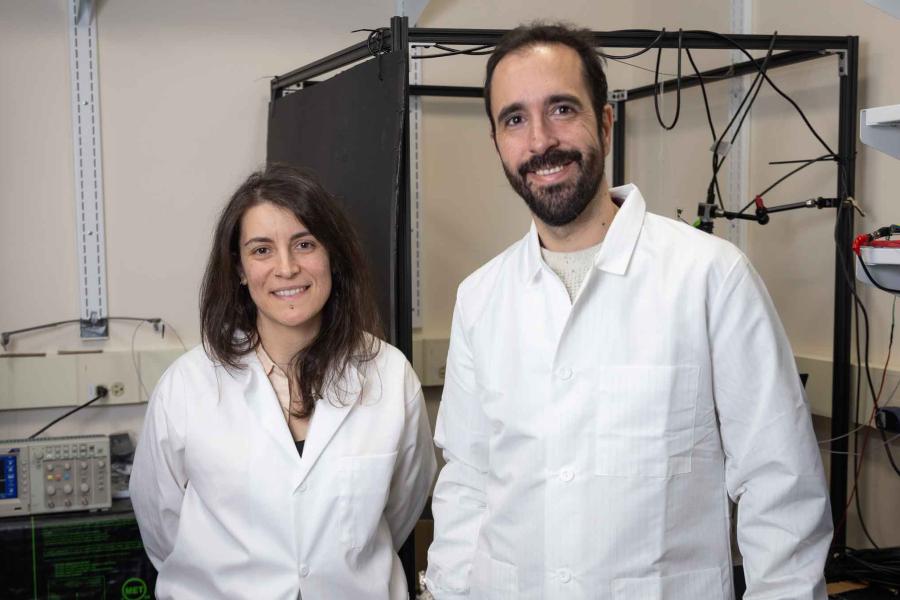A pair of researchers in the Department of Neurobiology and Behavior are designing new technology and research methods to discover how brain circuits support learning and memory.
The Brain Computation and Behavior Lab, led by Antonio Fernandez-Ruiz, an assistant professor and Nancy and Peter Meinig Family Investigator in the Life Sciences in the College of Arts and Sciences, and Azahara Oliva, also an assistant professor in A&S, studies both spatial and social memory in rodents using a combination of methods — naturalistic behavioral tasks, in vivo electrophysiology, calcium imaging, optogenetic manipulations (using a combination of light and genetic engineering to control brain cells) and anatomical circuit mapping.
“I think of the brain as a complex system, with so many components coordinating in a precise balance for the system to work,” Oliva said. “But this system, is not only the sum of its parts, once is all functioning, very interesting processes emerge, such as the ability to generate memories - we remember things since very early on in our life, yet we never stop learning new stuff.”
Fernandez-Ruiz said he initially became interested in neuroscience from a philosophical perspective.
“One question that intrigued me was: if they take your memory away from you, are you still you anymore?” he said. “When you go to sleep, there is a stream of consciousness, this internal dialogue that is suddenly interrupted, but when you wake up, you can go back to your memories in the same place as before. Memories are the central most important element of your identity.”
Both say they turned to science to explore their curiosities in this area. In some ways, Oliva and Fernandez-Ruiz have embraced nontraditional ways of research.
“Many people have manipulated brain activity by silencing part of the brain and then seeing if the animal can’t remember, but that’s not a good way to do things because one area of the brain does so many things,” Fernandez-Ruiz said.
“Instead, we are training our animals to do multiple tasks in different contexts, then, manipulating selected neural processes during specific times and seeing whether or not they are able to transfer previously learned information to new situations,” Oliva said.
Her work also includes research into the mechanisms of memory consolidation during sleep. “For long, we were wondering how the brain makes room for more and more memories, almost during a lifetime! The answer is a balance in the system during sleep. So we are tracking how different neural processes emerge during sleep to consolidate memories, but also to reset the neurons and make them available for more learning,” she said.
The Brain Computation and Behavior Lab contains several rooms where mice and rats lounge around in various enclosures. During training, they are placed onto tracks where researchers use food to train them to take certain pathways. After they are trained, they receive implants so that Fernandez-Ruiz and Oliva can study how their brain circuits are remembering the tasks or what is happening while they are sleeping.
The pair of researchers has worked with engineers as well as outside companies to design and build electrodes that can measure and analyze neural activity in many regions of the brain at the same time.
Their work has applications for many diseases that affect the brain, Fernandez-Ruiz said, including schizophrenia, Alzheimer’s and epilepsy, a research line that they are exploring in collaboration with Chris Schaffer and Nozomi Nishimura, both professors in the College of Engineering’s Meinig School of Biomedical Engineering.
“Since we know that there are specific neural patterns important for memory, we can specifically detect those patterns and then interfere with them through optogenetics,” he said. “An implant could be developed to detect a seizure before it happens and stop the brain activity that will cause it or detect the onset of schizophrenia early on in a much less invasive way.” This same process might be able to boost neural patterns that could revert memory deficits in patients with Alzheimer’s.
The pair has also started a collaboration with Michael Sheehan, an associate professor of neurobiology and behavior in the College of Agriculture and Life Sciences and a Nancy and Peter Meinig Family Investigator in the Life Sciences, and Klarman fellow Matthew Zipple (A&S) to conduct experiments with rodents in a natural outdoor setting near Cornell’s Ithaca campus. Together, they plan to investigate the neural mechanisms of natural behaviors, a field that has been traditionally very strong at Cornell.
“We piloted this program by releasing some mice out there with implanted electrodes to see how the brain works in their real world, as animals natural experience— forage for food and look for shelters or develop a social structure,” Oliva said.






